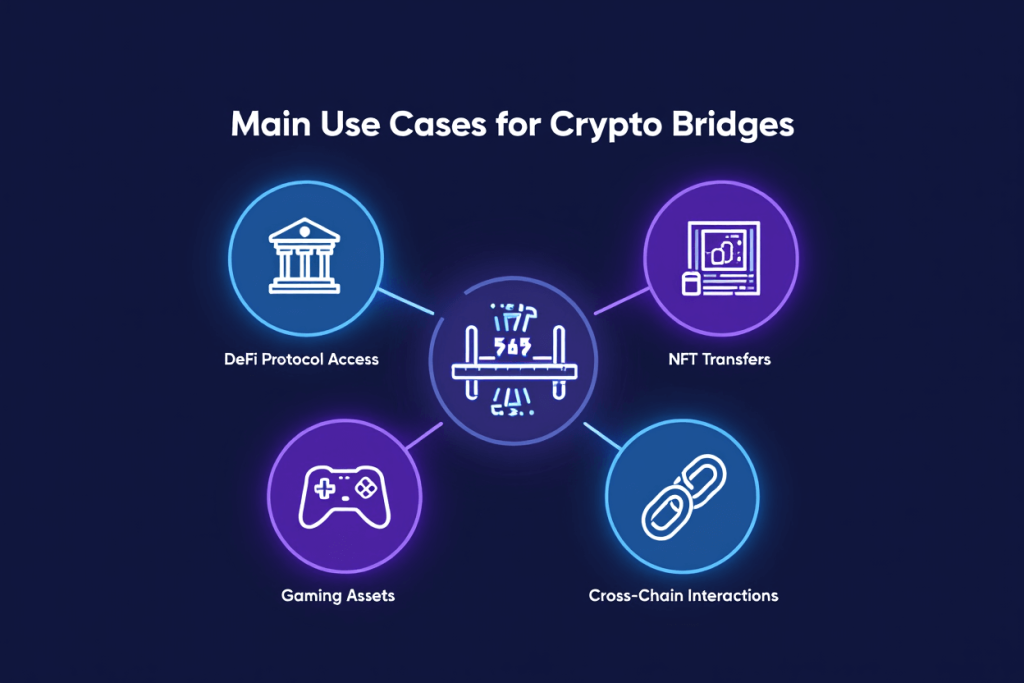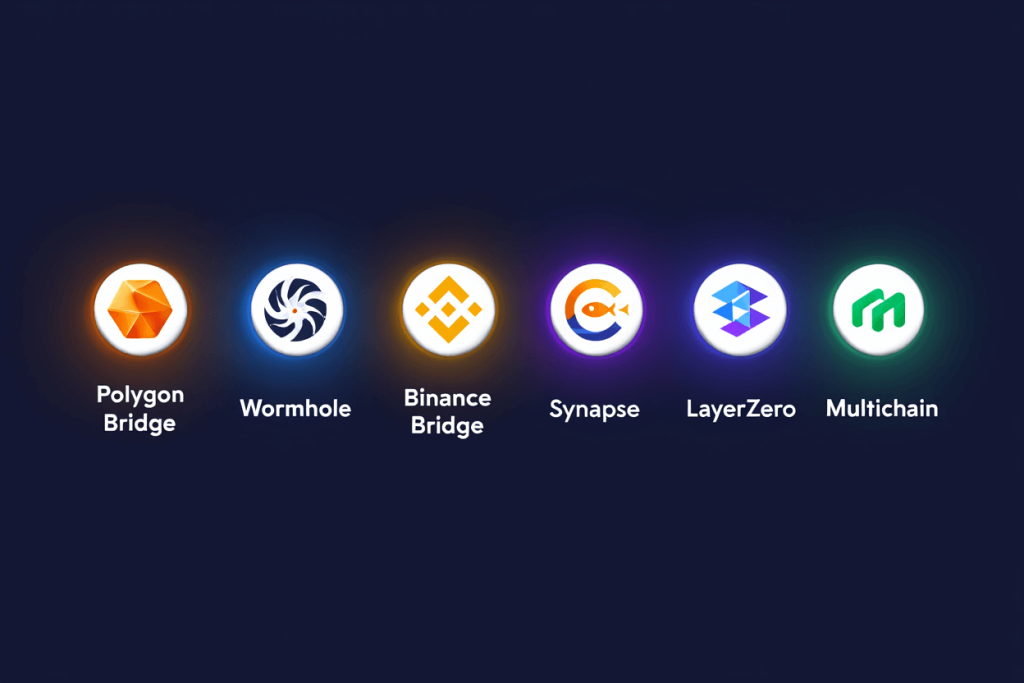Physical Address
304 North Cardinal St.
Dorchester Center, MA 02124
Physical Address
304 North Cardinal St.
Dorchester Center, MA 02124

What does bridging mean in crypto? And why is everyone talking about it in 2025? As the number of blockchains and decentralized applications (dApps) grows, the ability to move assets and data between networks is now a core crypto need , not just a nice to have. Without bridges, each blockchain is like a casino with its own chips or an airline with its unique frequent flyer miles: your assets are stuck unless you swap them, often at a cost.
In this deep guide, we’ll explain what crypto bridging is, why it’s necessary for blockchain interoperability, how crypto bridges work, their main types, real-world uses, and the possible risks and future trends. Whether you’re a newcomer or a DeFi pro, you’ll find practical tips and insights to make the most of cross-chain crypto in 2025.
Bridging in crypto is the process of transferring digital assets or data from one blockchain network to another using special protocols called crypto bridges. The core function of a bridge is to allow tokens, NFTs, or sometimes smart contract instructions to move cross-chain, enabling interoperability between previously isolated blockchains.

This sets the stage for understanding why bridges matter and the language you’ll need to navigate them.
Blockchains are naturally walled gardens. Ethereum, Binance Smart Chain, Solana, and others all build their own decentralized networks, but these systems can’t talk to each other natively. That lack of communication is a roadblock for users and developers who want to use assets or dApps across multiple chains without selling or swapping at a loss.
Without bridges, every blockchain operates in a silo, limiting the full power and flexibility of decentralized finance and web3.
Crypto bridging may sound technical, but here’s a beginner-friendly breakdown of how it typically works:
Key concepts: Smart contracts ensure the locking/minting process is automated and trustless, while validators or operators confirm cross-chain events. Wrapped tokens act as 1:1 stand-ins, enabling smooth movement across blockchains. For example, a user can bridge USDC from Ethereum to Avalanche using a platform like Synapse, quickly gaining access to new DeFi apps while keeping their original funds safe.
Crypto bridges are not all created equal; they differ in who runs them, how decentralized they are, and what assets or applications they support.
| Name | Trust Model | Main Feature |
|---|---|---|
| Polygon Bridge | Trustless | Ethereum & Polygon transfer |
| Binance Bridge | Trusted | BSC ↔ Ethereum; wide asset support |
| Wormhole | Validator-based | Many chains, NFTs, DeFi |
Understanding these differences can help users choose the right bridge for their needs.
Here are the main use cases for crypto bridges:

Bridging is already a massive market: By late 2024, daily volumes on leading bridges surpassed $500 million, and the number of unique bridge users climbed well over 2 million (source: Dune Analytics).
Explore more crypto insights at our Cryptocurrency Category.
Tips: Watch out for fake bridge sites. Check fees beforehand as some bridges charge more during busy times. If unsure, test with a tiny transfer before sending large amounts.
For example, the Wormhole hack led to over $300 million lost overnight, while Multichain’s 2023 incident froze user funds for months. To minimize risk, only use bridges with strong, public audits, start with small sums, and monitor community reports for recent security events.
As blockchains become more interconnected, the future of bridging is fast-evolving. Experts predict that in 2025, major growth areas include:
New cross-chain alliances are forming between industry leaders to make DeFi, NFTs, and gaming truly accessible, no matter the underlying blockchain.
Crypto bridging can feel confusing at first. Here are answers to some of the most-asked questions, providing clear reference points for 2025’s rapidly changing landscape:
Are bridged tokens identical to native tokens?
No, bridged tokens are wrapped representations pegged to the original, but they aren’t the same as native tokens. They carry added smart contract and bridge risks. See explanation in the How Bridging Works section above.
Can you bridge any crypto asset?
Not all tokens or NFTs can be bridged. It depends on bridge support and technical compatibility. Always check the bridge’s documentation.
Is bridging reversible?
Yes, most bridges allow you to unwrap tokens and retrieve your original assets by reversing the process.
Does bridging cost more than swapping on exchanges?
It can, especially when gas fees are high or bridges charge withdrawal/deposit fees. However, bridging doesn’t usually incur trading slippage like centralized exchanges do.
Is using a bridge safe?
Top bridges with strong audits and long track records are generally much safer, though no bridge is without risk. Always research before transferring significant amounts.
See more related articles:
Every leading crypto bridges:

| Name | Supported Chains | Trust Model | Fees | Speed | Security Notes | Year Launched |
|---|---|---|---|---|---|---|
| Polygon Bridge | Ethereum, Polygon | Trustless | Low | 2–20 mins | Widely audited | 2021 |
| Wormhole | Ethereum, Solana, BSC, more | Validator | Moderate | Fast | Validator-based | 2021 |
| Binance Bridge | Ethereum, BNB Chain | Trusted | Low | Very fast | Run by Binance | 2020 |
| Synapse | 20+ EVM chains | Liquidity | Varies | Immediate | Large liquidity pools | 2021 |
| LayerZero | Ethereum, Avalanche, more | Trustless | Low | Fast | Cutting-edge security | 2022 |
| Multichain | 50+ chains | Trusted | Depends | Moderate | Past exploits | 2021 |
Different bridges excel in speed, breadth, trust level, or security, so your choice should depend on your use case and risk tolerance.
Bridging and swapping often get confused, but they solve different problems in crypto. Swapping means exchanging one asset for another (e.g., ETH for USDT) on the same or different chains, typically using a DEX or CEX. Bridging, by contrast, moves the same asset across chains (e.g., ETH on Ethereum to ETH or wETH on Polygon), with no change in the underlying coin type.
Crypto bridging is a cornerstone technology in 2025, letting digital assets and data flow between previously siloed blockchains. It opens doors for broader DeFi use, NFT portability, and seamless gaming experiences, but it also introduces unique security and liquidity risks. By understanding how crypto bridges work, from different types and use cases to best safety practices, you can navigate the growing multi-chain world with confidence. As the industry continues to innovate with zero-knowledge proofs and multichain standards, secure and efficient bridging will become even more crucial for everyone in crypto, from beginners to seasoned investors.
Web Tai Chinh is your up-to-date resource for all things finance. We offer fast, accurate financial news and crypto insights, empowering users to make informed decisions and understand the financial landscape, no matter your level of experience.
📞 Contact: 055 937 9204
✉️ Email: webtaichinh@gmail.com
📍 Address: 13 Ho Tung Mau, An Binh, Di An, Binh Duong